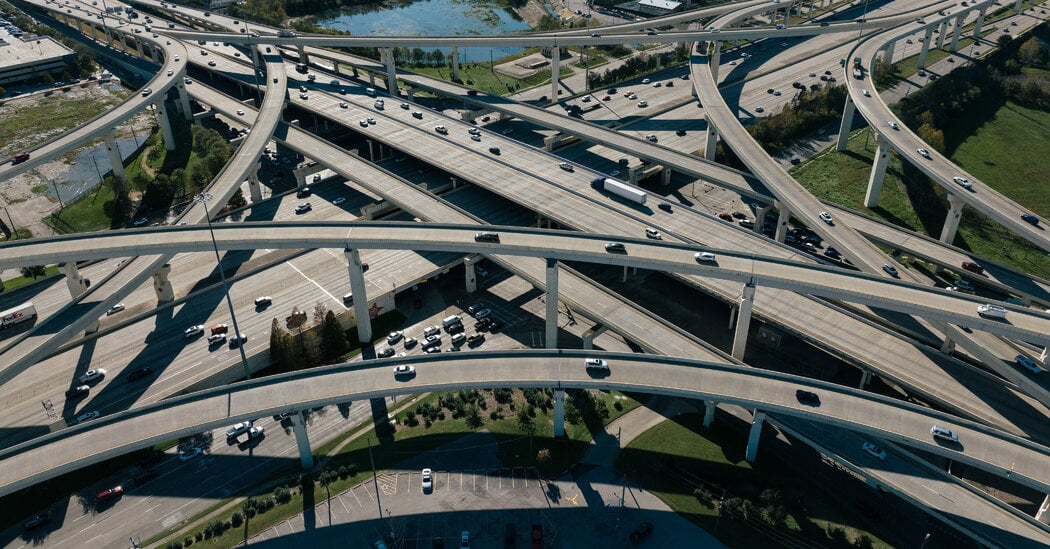For critics of widening projects, the prime example of induced demand is the Katy Freeway in Houston, one of the widest highways in the world with 26 lanes.
Immediately after Katy’s last expansion, in 2008, the project was hailed as a success. But within five years, peak hour travel times on the freeway were longer than before the expansion.
Matt Turner, an economics professor at Brown University and co-author of the 2009 study on congestion, said adding lanes is a fine solution if the goal is to get more cars on the road. But most highway expansion projects, including those in progress in Texas, cite reducing traffic as a primary goal.
“If you keep adding lanes because you want to reduce traffic congestion, you have to be really determined not to learn from history,” Dr. Turner said.



Not everyone can take public transit.
So they can use the thinner roads, which will be way less crowded when everyone else that can is using public transportation.
Did you really think this was a coherent response? It’s not like all roads are being removed.
That just leads to incredibly long commutes for the working class as they are forced to struggle through progressively worse traffic on neglected, overstrained highways. You need to invest in both mass transit and general transportation infrastructure.
Not sure how you came up with this fantasy tbh.
Do you think the working class isn’t going to use public transportation and will all drive? Do you think investing in public transportation means purposefully letting roads degrade? Neither assumption is based on anything I’ve said or in reality in general.
What do you even think my argument is?
The point is that diverting resources to public transportation will reduce traffic by providing an efficient alternative. Then you don’t have to expand roads to accommodate drivers because the bulk of commuters only really need good public transportation to get around.
All? No. Public transit is very useful. But there’s a lot of people who can’t afford rent in the city and must live outside the reach of a good public transit network. Or who keep working hours which don’t allow them to use the network. Or who needs to travel between two locations which would be an extreme journey for public transit.
That’s why you do both. Because not all people are going to be served well by any one solution.
I’m sorry but you don’t seem to understand how public transport works. Public transport usually does extend quite far outside the inner city, with efficient links into the city. That’s an incredibly common pattern for public transport.
Look at a city like London. Absurd rental prices. The working class lives well outside the city. Few people have cars.
The only situations where having a car tends to be preferable is if you live outside the city AND also work outside the city. And even then, bus routes usually alleviate the problem of getting between suburbs. And those routes usually aren’t as congested anyway.
My wife worked a job in a city 20 minutes by car from her location in another city, in a major metro area. Transit would have taken two hours because the focus was on bringing people to different locations, not between where she was going and where she needed to go. No matter how well planned the network, you can’t massively cover every route and every time of day. You cover the primary commutes of most people.
So invest in public transport to add more routes.
It’s like you are saying that we shouldn’t improve anything, because things are bad now. Circular and just nonsensical.
Yes. And in doing so you remove the vast majority of the cars from the road. So you have fewer, narrower roads. Which makes the living conditions of everyone more pleasant. And it enables more transportation options like bicycles, which covers many of the short-to-medium distance commutes which public transport might not be practical for, which even further reduces the demand for cars. It also incentivises, for the people who do actually need cars, the purchase of smaller vehicles, which even further increases pedestrian and bicycle safety. Which even further incentivises biking and walking…
And so on and so on…
The more we invest in car-centric infrastructure, the more people need cars to navigate the world, and the worse the world gets overall.
Again, how did you read everything I’ve written and act like the conversation is about one or the other? Did you even read what I wrote?
Not to mention you very clearly don’t understand how public transportation works based on where you think it goes between.
Alright, you’ve been a jackass from comment one, and I’m ending this. GFY and have a nice day.
You finally responded to something I actually said! Congrats on clutching your pearls instead of admitting you were misrepresenting what I was saying.
Also funny that I’ve never engaged in ad hominem but I’ve offended you so much that I’m a “jackass” and should “go fuck [myself]”.
Self awareness really isn’t your strong suit.
Who can’t?
Not with idiots fighting it every step of the way to make sure it’s as unreliable or nonexistent as possible.
but most people can
and, ironically, the commute would be better for drivers too, if most people were to take public transport, since roads would be less crowded (and only with people who enjoy driving, instead of people who are forced to drive)
Which is why the smart decision is to invest in both.
Besides, if you add an HOV lane to a public highway, you can double it as a bus lane, improving public transit. Roads are like rails for buses, after all.